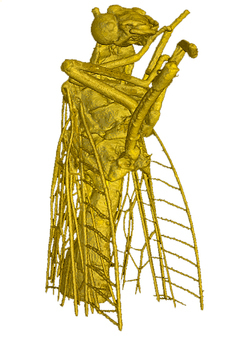Sep 1 2015
An innovative X-ray source is now showing what it can do. Researchers at the Max Planck Institute of Quantum Optics in Garching, the Ludwig Maximilian University Munich and the Technical University Munich have captured images of three-dimensional ultrafine structures of a fly measuring just a few millimetres using X-rays generated with the help of a laser.
 The world’s first image of a fly taken with the help of a laser-based phase-contrast X-ray tomography imaging method. It consists of around 1500 individual images. Even ultrafine structures appear in three-dimensional detail. In a conventional X-ray image, these would remain invisible. © Karsch/Pfeiffer
The world’s first image of a fly taken with the help of a laser-based phase-contrast X-ray tomography imaging method. It consists of around 1500 individual images. Even ultrafine structures appear in three-dimensional detail. In a conventional X-ray image, these would remain invisible. © Karsch/Pfeiffer
The researchers achieved the high resolution by using particularly brilliant X-radiation coupled with phase-contrast X-ray tomography. The new X-ray source could be used in medical science, providing detailed images, particularly of soft tissues that would be impossible today without huge expense. The new method may enable doctors to detect tumours in future at a stage where cancer can still be easily treated.
When the physicists from Garching and Munich illuminate a tiny fly with X-rays, the resulting image captures even the finest hairs on the wings of the insect. The experiment is a pioneering achievement. For the first time, the scientists coupled their technique for generating X-rays from laser pulses with phase-contrast X-ray tomography to visualize tissues in organisms. The result is a three-dimensional view of the insect showing numerous details.
The group of researchers headed by Stefan Karsch, Professor at Ludwig Maximilian University Munich, and researchers at the Max Planck Institute of Quantum Optics generated the brilliant X-ray light, which previously could only be produced in accelerators the size of a sports hall, by accelerating electrons to nearly the speed of light over a distance of approximately one centimetre by laser pulses lasting around 25 femtoseconds. A femtosecond is one millionth of a billionth of a second. The laser pulses achieved a power of approximately 80 terawatts, or 80 million gigawatts. By way of comparison: an atomic power plant generates around 1.5 gigawatts.
Electrons surfing on an electrical field
First, a laser pulse carrying this concentrated power ploughs through a plasma consisting of positively charged atomic cores and their electrons like a ship through water, producing a wake of oscillating electrons. This electron wave creates a trailing wave-shaped electric field structure on which the electrons surf and are accelerated in the process. The particles then start to vibrate, emitting X-rays. In this way, each light pulse generates an X-ray pulse. The X-rays have special properties: They have a wavelength of approximately 0.1 nanometres (a nanometre is one millionth of a millimetre), a single pulse of the radiation lasts only about five femtoseconds and is spatially coherent, i.e. the electromagnetic waves all appear to emanate from a single point source.
Until now, X-rays with such properties could only be produced in particle accelerators requiring more space than a football field. By contrast, the experimental X-ray source of the Max Planck researchers fits in a laboratory.
For the first time, the researchers combined their laser-driven X-rays with an X-ray method called phase-contrast X-ray tomography, which was developed by a team headed by Franz Pfeiffer at the Technical University Munich. Instead of the usual absorption of radiation, they used X-ray refraction to accurately image the shapes of objects, including soft tissues. This can only work, however, with coherent light, such as the light produced by Stefan Karsch’s group of physicists.
Tumours less than one millimetre in diameter can be detected
By combining this method with brilliant X-ray light, the scientists are able to visualize structures measuring just one to ten micrometres, corresponding to one hundredth to one tenth the diameter of a human hair. They were even able to produce three-dimensional images of a body with the new method, as the X-ray pulses can scan an object section by section. In this way, for example, around 1,500 individual images were taken of the fly, which were then assembled to form a 3D data set.
Due to the shortness of the X-ray pulses, this technique may be used in future to capture ultrafast processes on the femtosecond time scale, e.g. in molecules – as if they were illuminated by a femtosecond flashbulb.
The technology is particularly interesting for medical applications, as it is able to distinguish between differences in tissue density. Tumour tissue, for example, is less dense than healthy tissue. In future, the high resolution of the especially brilliant X-ray source could thus enable doctors to detect tumours that are less than one millimetre in diameter in a very early stage of growth. Until that time, the physicists will, however, have to further refine their X-ray source: they have to shorten the wavelength of the X-rays even more in order to penetrate thicker tissue layers.